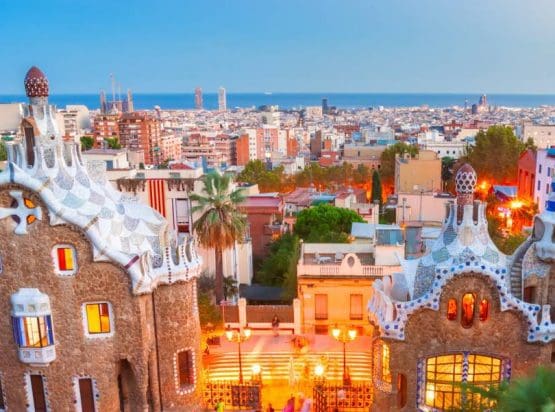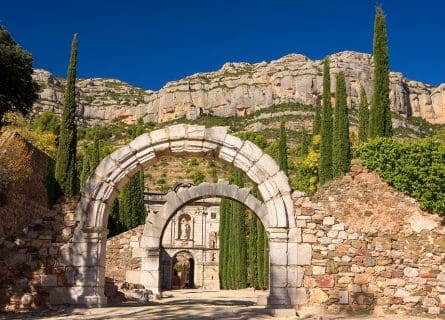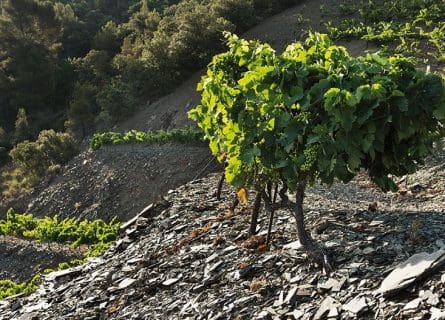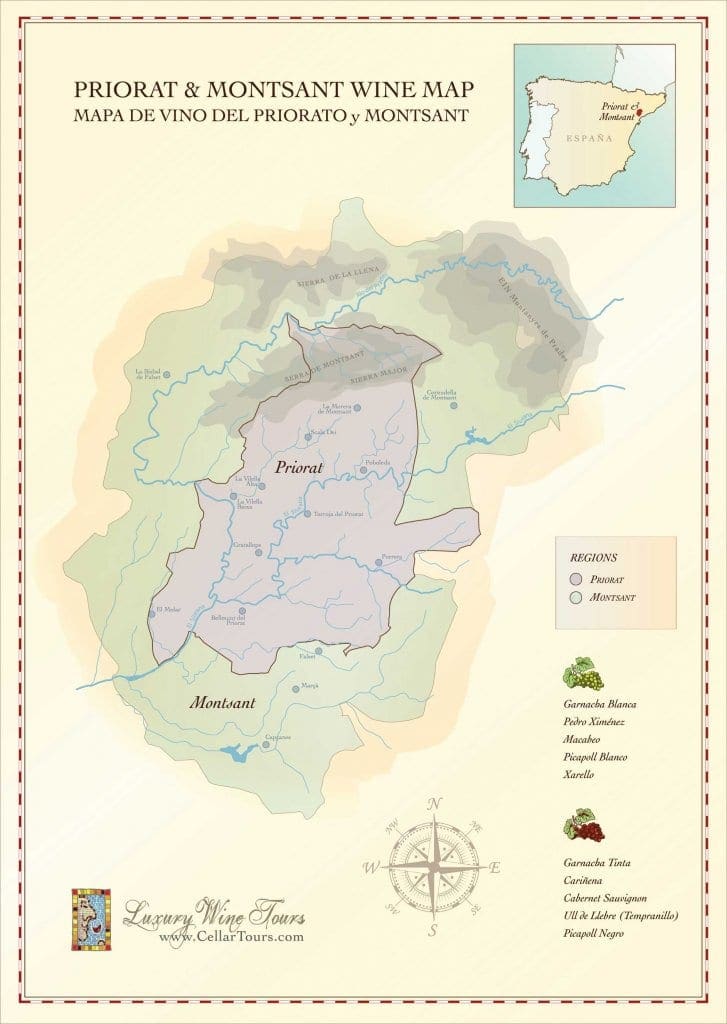Immerse yourself in Barcelona's vibrant flavors and uncover hidden culinary gems with our expert insider guides. Plan an unforgettable trip today!
Read more
EXPLORE ALL OUR CATALUNYA WINE REGIONS GUIDE
Last updated: November 25, 2024
Priorat is a small region with gigantic appeal. It is the birthplace of intense, minerally reds that many writers and sommeliers consider Spain’s most complex and magnificent wines. The distinctive slate-and-quartzite soil (locally called llicorella), abundant sunshine, and an energetic group of young winemakers have earned a reputation for innovation in this region. Critical recognition, meanwhile, has elevated these exquisite wines to collectible status; aficionados will pay lavish sums for top cuvées like L’Ermita. Few wines in Catalunya or Spain can justify an $800-plus price tag. But Priorat has managed to pull it off.
Yet the region’s global success is more than just about hype and luxury branding. Few can resist the voluptuous concentration and dark fruit profile that defines Priorat – critics used to joke that you need “a knife and fork” to drink these potent wines. However, that assessment is outdated; modern Priorat offers freshness, precision, power, and richness. Expressive, fresh, and packed full of mineral-infused complexity, Priorat has earned a devoted following in Spain and beyond.
Discover more about Spanish Wine

The region has a winemaking history stretching back to the Middle Ages when monks of the La Cartoixa D’Escaladei (the “Staircase to God” Carthusian monastery) began making wine for Holy Communion. This was the first Carthusian order founded in Spain, and Priorat owes its name to the monastery. The monastery’s leader, called a prior, ruled over his territory (his Priorat) with absolute control. Yet vines had been planted in southern Catalunya centuries before this seminal moment in Priorat’s history.
Indeed, the Roman historian Pliny the Elder recorded his great admiration for the wines of Tarragona (a city to the southwest of Barcelona), describing them as “some of the best in the Empire.” Such was the reputation of these venerable vintages that the Emperor himself demanded a steady supply enjoyed in the splendor of ancient Rome.
However, the Western Roman Empire collapsed in the 5th century, paving the way for the Dark Ages. Winegrowing was abandoned as rival civilizations fought for control over Catalunya – a lucrative prize rich in mineral and agricultural wealth. The Vandals, Goths, and Visigoths attempted to establish a permanent base in northeastern Spain but failed. Even the well-trained armies of the Moorish general Tariq (the Moors invaded Spain in 711) could not hold onto Catalunya for more than a few decades.
They were defeated by Frankish knights based in neighboring Roussillon. Their forces retook Barcelona in 801 after a relatively brief skirmish. By the Middle Ages, Muslims had retreated to central and southern Spain, while the Atlantic regions—Basque Country, Asturias, and Cantabria—were never subject to any discernible Moorish influence.
Monastic Influence on Catalunya’s Wine
By the 13th century, Catalunya’s wine industry was back in full swing. Vines had been reintroduced by Benedictine and Cistercian monks from Burgundy and the Rhine; many relocated to Spain following the news that the tomb of Santiago de Compostela had been excavated in Galicia. Their unique knowledge was invaluable in helping to rebuild and popularize Spain’s wine industry; trade with New World colonies generated much wealth in the 17th and 18th centuries.
Then it all fell apart. The phylloxera louse arrived on European soil in the 19th century, destroying Catalunya’s winemaking industry and reducing the area under vine from 5,000 hectares to just over 600. As a result, farmers turned their attention to other crops like almonds and olives. Only in the past few decades have vast swathes of land been devoted to vineyards once again.
Modern Revival
The catalyst for Priorat’s revival was the arrival of Álvaro Palacios, René Barbier, and Switzerland’s Daphne Glorian. This trio saw the untapped potential of the region’s llicorella soils and planted Grenache, Carignan, and Syrah in Priorat’s most privileged climats (vineyard sites). The first vintages stunned the critics and electrified buyers: amazingly concentrated reds full of terroir character thanks to the very low yields produced by the region’s harsh conditions. These low yields, in addition to the intense manual labor required to make wines here, ensure that Priorat markets some of the most expensive bottles in Spain.

Priorat is a truly captivating destination. The vineyards are situated in northeastern Spain, less than 40km from Tarragona, in an area of outstanding natural beauty. Indeed, centuries of poverty meant that most of the region looks much as it did in the Middle Ages, with unspoiled natural landscapes interrupted by stone farmhouses, small quaint villages, castle complexes like Siurana, and historic churches and chapels.
Meanwhile, mile after mile of hilly terrain reveals terraced vineyards protected from downpours in the fall by the majestic Sierra de Montsant mountain range. Vertigo sufferers note that the relentless relief of Priorat’s landscape means that vineyards must be planted in steep terraces similar to those found in the Douro Valley. The terraces climb the hillsides in neat, curving rows that give the appearance of being drawn onto the land. On the steepest slopes, they are like enormous staircases, creating a pretty picture but back-breaking work for those who have to pick the grapes by hand – machine-harvesting is impossible here. There is also scant rainfall in Priorat – often fewer than 500mm a year – and abundant sunshine; summer temperatures frequently rise above 35°C in July and August. Achieving physiological ripeness in such a climate is almost too easy.
Yet the best of Priorat is always fresh and balanced. The secret behind this precision is the damp, infertile subsoils that greatly aid in preventing hydric stress during the ripening season. Of course, the region is most famous for the llicorella topsoils slate-and-quartzite terroir that is free-draining and can reflect heat into the vine canopy. In addition, vineyards are planted at altitudes ranging from 100m to 700m above sea level, which affords all the benefits of diurnal temperature variation – a significant difference between day and night temperature helps preserve acidity in the wines. Today there is a relatively eclectic palate of varieties grown in the appellation. However, old bush vine Carignan and Grenache yield the best results in Priorat, ripening tiny berries of remarkably concentrated fruit. The resulting wines have no equal in Spain: complex beauties with enough structure and ‘stuffing’ to last a lifetime.

Like all wine regions, Priorat has a trademark style: voluptuous red blends that often contain a good dollop of Grenache and Carignan. The vast majority of wine in the appellation conforms to this paradigm, regardless of the price tag. However, Priorat has also branched into white wine production, crafting a tiny volume of Vino Rancios (oxidized wines aged for five years in glass demijohns). The sweeter versions can be an excellent substitute for Port when the Stilton makes an appearance.
However, the critical mass of wines produced here are dry, vinified in a mixture of stainless steel, concrete, and wood. All the top wines—l’Ermita, Clos Erasmus, Clos Mogador—are matured in a certain percentage of new barrique, although amphorae are making inroads in Priorat, as elsewhere.
Priorat’s Unique Wine Classification
Nevertheless, Priorat’s winemakers will always insist that terroir is far more important than what happens in the cellar. The region was one of the first in Spain to devise a codified ranking in the Burgundian mold: 12 distinct villages are classified as Vi de Vilas. The project began in 2009 when Priorat’s top winemakers convinced the ‘Consejo Regulador‘ to undertake a detailed and painstaking study into the region’s different soils and mesoclimates. That lengthy process culminated in the unveiling of a new terroir pyramid in 2019; Vinya Classificada and Gran Vinya Classificada are Priorat’s equivalent of Premier/Grand Cru wines.
A concurrent framework classifies wines according to the period of maturation in oak and bottle. Thus, Crianzas should be aged for at least two years before release: six months in oak and the remainder in bottle. Reservas and Gran Reservas, meanwhile, are aged for a minimum of three and five years, respectively; Reservas must spend one year in oak, while the top tier is aged for a minimum of two years in oak and three years in bottle. However, some producers eschew these regulations in favor of a terroir-driven approach.
Learn more with our Guide to the Wine Types and Classifications in Priorat: Read more
To say that Priorat is overwhelmingly associated with concentrated reds is an understatement. Of course, it’s natural to think of the region as primarily a red wine producer; media hype and critical attention have coalesced around Priorat’s signature export. Yet the global market increasingly covets aromatic whites, a fact which is encouraging more growers to try their luck with Garnacha Blanca, Macabeo, and even Chenin Blanc. Local demand has also increased, and quality has been rising, too, as winemakers grapple with a new challenge. Granted, it’s still early days, and the overall volume is very small. But white Priorat can be just as electrifying as the region’s flag-bearer.
The Emerging Profile of Priorat Blancos
Stylistically, Priorat Blancos runs the whole gamut from oak-aged Garnacha Blanca to fresh and fragrant Chenin Blanc – a rival to the Western Cape. But, every bottle has that inimitable stamp of Priorat terroir: a tense minerality that unfolds in the mouth with unbelievable precision and focus. Indeed, the slate-and-quartzite soils of the zone are ideally suited to producing very fine whites – diurnal temperature variation is responsible for their crunchy acidity and beautiful perfume. Tasted blind, you’re fooled into thinking that a particularly good vintage of Hermitage Blanc has graced your palate, yet growers are still finding their feet. It’s official: Priorat has another exciting string to its bow. The future is white.
Chenin blanc is a white wine grape varietal from France's Loire Valley Wine Region. It's a highly versatile grape that produces delicious, light-bodied wines.
Find out moreDiscover the Allure of Grenache Blanc: Full-Bodied White Wine from Northeastern Spain. Experience the Richness of High Alcohol, Low Acidity Wines.
Find out moreDiscover Viura: Rioja's Prominent White Grape & Catalonia's Macabeo. Explore its versatility in exquisite wines. A must-read for wine enthusiasts.
Find out moreThe Picapoll Blanco grape is a captivating indigenous white grape variety from Spain, renowned for its intriguing flavors, historical significance, and remarkable versatility. With its vibrant acidity, citrus and stone fruit notes, and herbaceous undertones, wines crafted from Picapoll Blanco offer a refreshing and crisp sensory experience.
Viognier comes from the northern Rhône valley AOC of Condrieu and is where its most famous white wines are produced.
Find out moreUnveiling Xarel-lo: A Key Grape in Catalonia's Cava Sparkling Wine. Discover the Intriguing Role of Xarel-lo in Spain's Sparkling Delight.
Find out moreCabernet Franc grape is a close relative of Merlot and Cabernet Sauvignon and is the principal blending grape used in Bordeaux.
Find out moreDiscover the irresistible allure of Cabernet Sauvignon—a worldwide favorite with robust, dark-bodied flavor. Unleash your wine journey today!
Find out moreCarignan is a red grape variety that grows mostly in Southern France, and is often used as a blending grape
Find out moreGarnacha: Spain's Red Gem. Akin to Pinot Noir, it bridges terroir and winemaking, crafting captivating expressions.
Find out moreMerlot is the most cultivated grape in Bordeaux and closely related to Cabernet Franc
Find out moreSyrah is dark-skinned and perhaps the most underrated of the 'noble' red grape varieties.
Find out moreDiscover Tempranillo: Spain's iconic red grape. From Ribera del Duero to Toro, it yields concentrated wines. Explore its synonyms and unleash its prowess.
Find out moreHearty Catalan cuisine is the ideal accompaniment to the potent wines made here. Robust botifarra sausages, a hearty veal and mushroom dish called fricandó, and roasted vegetables served with the tangy “romesco” sauce are a few favorite dishes. No matter what you eat, it will likely be accompanied by the fragrant arbequina olive oil, made from the tiny arbequina olives that grow near the vineyards. In Priorat, bad gastronomy and lazy cooking are not tolerated! On the other hand, seasonal ingredients and traditional recipes are considered sacrosanct.
Guide to Catalan Gastronomy: Read more
If you would like us to customize an exclusive luxury tour, contact us and let us know your travel plans. We offer luxury food and wine tours for private groups of a minimum two guests. In addition, all of our private, chauffeured tours are available year-round upon request.

